World No Tobacco Day: History and Significance Behind the Observance
The World No Tobacco Day is observed every year on May 31. Read further to know the theme, history and significance of the day.

Every year, World No Tobacco Day is observed on May 31 as part of the United Nations Environment Programme (UNEP) and the World Health Organization (WHO). The day is observed with the purpose to raise awareness about the negative impacts of Tobacco on human health and the environment. The day raises awareness among people about how to keep themselves and their environment safe from the risk of Tobacco.
History of the Day
In the year 1987, the member states of WHO created the World No Tobacco Day, as mentioned on the website of WHO. In 1987, the World Health Association has passed a resolution to create the World No Smoking Day.
In 1988, the World Health Association passed another resolution that established May 31 as World No Tobacco Day. Every year the day is observed with various campaigns across the globe focusing on the key impact of tobacco use and the tobacco trade.
Read More: Covid Updates: India Reports 2,338 Fresh Cases
Significance of the Day
The consumption of tobacco in any manner may lead to hazardous health issues including lung cancer. As per the data, out of the total patients with lung cancer, 80%-90% have been found to be a user of tobacco smoking.
The theme of the Day
This year, the theme to observe the World No Tobacco Day is "Tobacco: Threat to our environment", as per the UNEP website. The theme talks about the impact made by tobacco and its related product on the environment. The cultivation, production, distribution, and consumption of Tobacco impact our environment.







